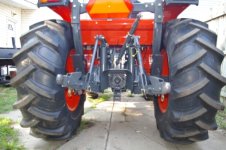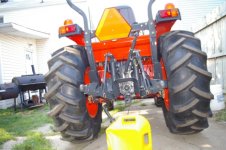I agree. The R4s look like the toy trucks you had as a kid -- all big and tough looking. For lack of any other standard to judge, a lot of CUT buyers go for them, and like you said, dealers like to sell them due to the higher profit.
Regarding traction, consider that it comes from two sources -- ( Now is about time for Patrick to get into this one ) -- One is the friction between the outer surface of the tire and the medium on which it is being driven. Turfs provide a lot of surface and are very good for traction on many surfaces. The second source of traction comes from the tires sinking into the material in question and then needing to displace the material or move the tractor forward as the tire revolves. This is where R1s excel, as typified by a heavy tractor sinking partially into the soil as it pulls a plow or other heavy implement.
R1's are good on snow IF the snow is of the right consistency to pack and resist shearing as the tire turns. If the snow is light and powdery or overcoating a layer of ice so the snow itself comes apart as the tire turns, you have a problem.
Turfs would be superior to R1s on ice unless the ice surface was so smooth that there were no small ridges for the tire to deform around OR the tire compound had a high glass transition temperature causing it to be very hard at low temperatures. If the rubber stays soft and the pressures are not too high, the tire will deform around the tiny irregularities in the ice surface and work pretty well, at least better than the R1 since there is more tire to ice contact.
R4s as often stated, are a compromise, better in some situations and worse in others. As has also been stated, traction issues are only partly due to the tire. The stuff on which you drive has a huge impact on whether you move or not. R2s (rice tires) are a great example. They work wonderfully in the terrain for which they are designed -- rice paddies and similar very wet environments that are only marginally thicker than the Mississippi River -- but are not much use in other places.
So, when you need to make the choice, analyze your wallet, your ground, your winters and your uses. Pick the one which provides the best traction some of the time or sufficient traction most of the time, or whatever your priorities lead you to. Or buy 3 (or 4 if you like R2s) sets of tires and rims plus chains, wheel weights, Rimgard by the barrel, and you're all set for what nature throws at you.



